

Fat is a flavor carrier, which would explain the boost in flavor. In short, the difference between oat milk vs whole milk is that oat milk is lactose-free, vegan friendly, and contains less saturated fat, cholesterol, and. Moreover, the puddings made with the higher-fat milks were thought to taste more chocolatey and decadent, with the whole milk pudding having a distinct velvety mouthfeel. The pudding made with skim milk was not by any means a disaster, but it was nowhere near as rich and creamy as the pudding made with either the 1 percent or whole milk. 2 percent milk also contains less overall creaminess and has a slightly ‘watery’ texture compared to its. 2 percent milk is lower in fat than whole milk, containing only 2 of juice versus the 3.25 found in whole milk. Clearly, this cake needs mik with some fat. 2 percent and whole milk both come from the same source, but have some distinct differences in nutrition levels and taste. Surprisingly, the cake made with 1 percent milk was very similar in tenderness to the whole milk cake. Tasters found the cake made with skim to be dry and tough and the cake made with whole milk to be moist and tender. That's good news: You can use whatever you have in your fridge. While a couple of very particular tasters could pick out the pancake made with skim milk, the majority could not make out much difference between any of the pancakes. Each recipe originally called for whole milk. But in the end, does it really matter? Could the average palate detect a difference, or are they pretty much interchangeable? We decided to test whole milk (which is 3 1/2 percent fat), 1 percent milk, and skim milk (which must contain less than 1/2 percent fat) in three recipes: pancakes, yellow layer cake, and chocolate pudding. "You'd rather a child drink milk than not drink milk at all," says Gans.We've all seen those recipes (including our own) that specify what kind of milk to use: whole, low fate, nonfat. The point, say Harrison and Gans, is that children consume enough milk ( or other dairy) to reap the benefits-calcium, protein, Vitamin D, and yes, fat. "If you help them keep that up, allowing them to tell you their appetite cues, not pushing more food on them when they say they're done, then they'll also self-regulate with milk," she says.

They'll eat when they're hungry and stop when they're full, and that goes for drinking milk, too. Kids are "hard-wired to find satisfaction and pleasure in their food," says Harrison. And if your child likes the taste of low-fat milk, the common option in most daycares and schools, so be it. "If you're kid is really digging whole milk and that's what they're used to and they're getting enough of it, then by all means keep it up," she says. Paying attention to your child's preferences-that's the key, says Harrison, more so than worrying whether they should be getting more or less fat or calories. ( Vitamin A is also fat-soluble, but the form of it that's naturally in milk doesn't need fat to be absorbed, says Gans.) With whole milk, you get the whole package, but drinking skim milk on its own limits your body's ability to absorb the D, says Harrison. Vitamin D, which is added to milk and helps with calcium absorption, is fat-soluble, meaning you need fat in order to absorb it. There's also the issue of vitamin absorption. They also noted the rise in consumption of flavored and sweetened milks, which essentially undermines the nutritional value. This not only leads to weight gain but also raises triglyceride levels, which can be more harmful to heart health than the saturated fat in whole milk. David Ludwig argued kids are better off drinking whole milk.īecause lower-fat milk is less satiating than whole milk, the doctors wrote, it's more likely a kid will make up for it by then eating more starchy, sugary, refined foods. In an attention-getting 2013 editorial in the journal JAMA Pediatrics, foremost nutrition experts Dr.

"Kids under 2 benefit from drinking whole milk, so why are we afraid to keep giving it to them? That's the fat phobia."

"The research, in adults at least, in these large-scale studies is showing no difference between the health outcomes of people who drink whole milk and those who drink low-fat milk," says Harrison.


 0 kommentar(er)
0 kommentar(er)
